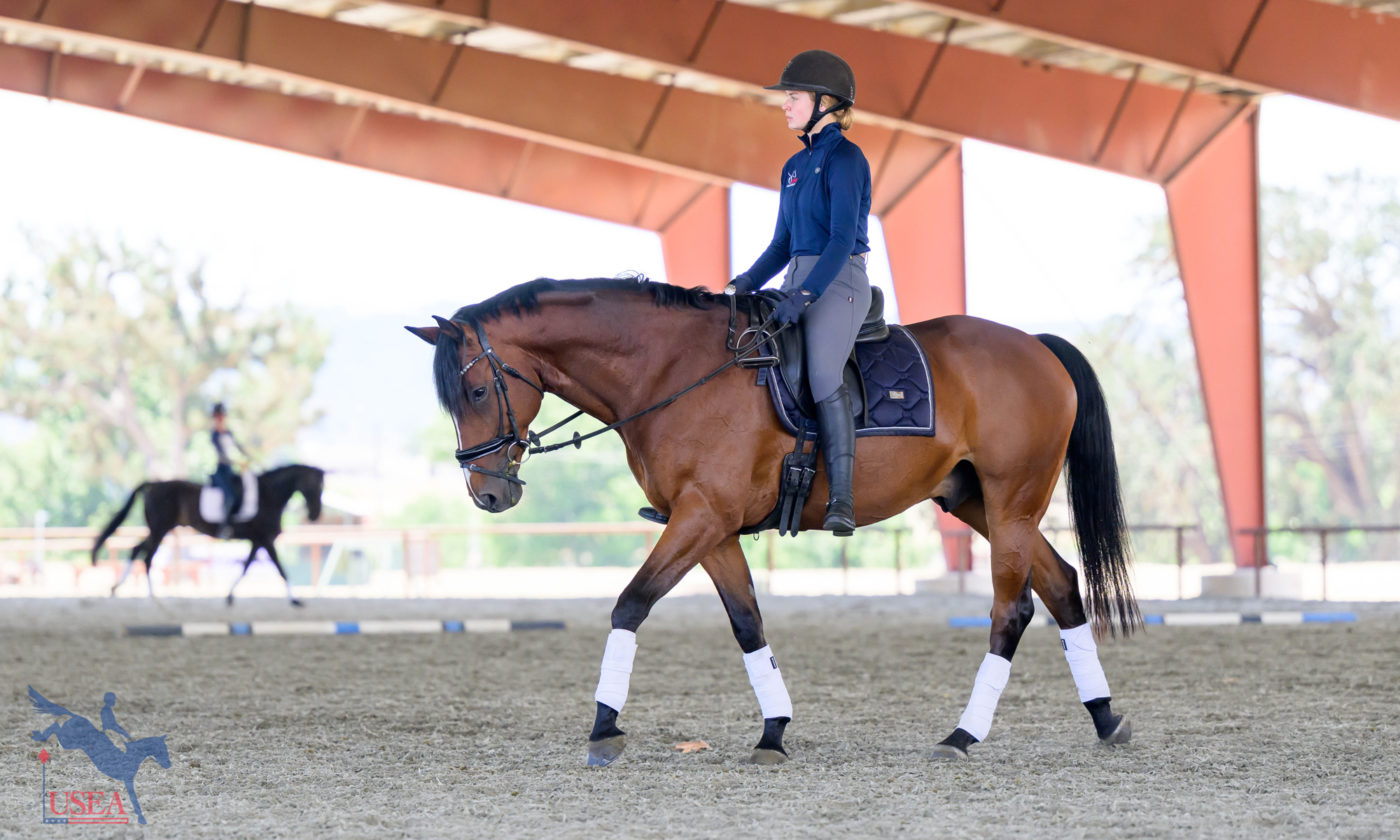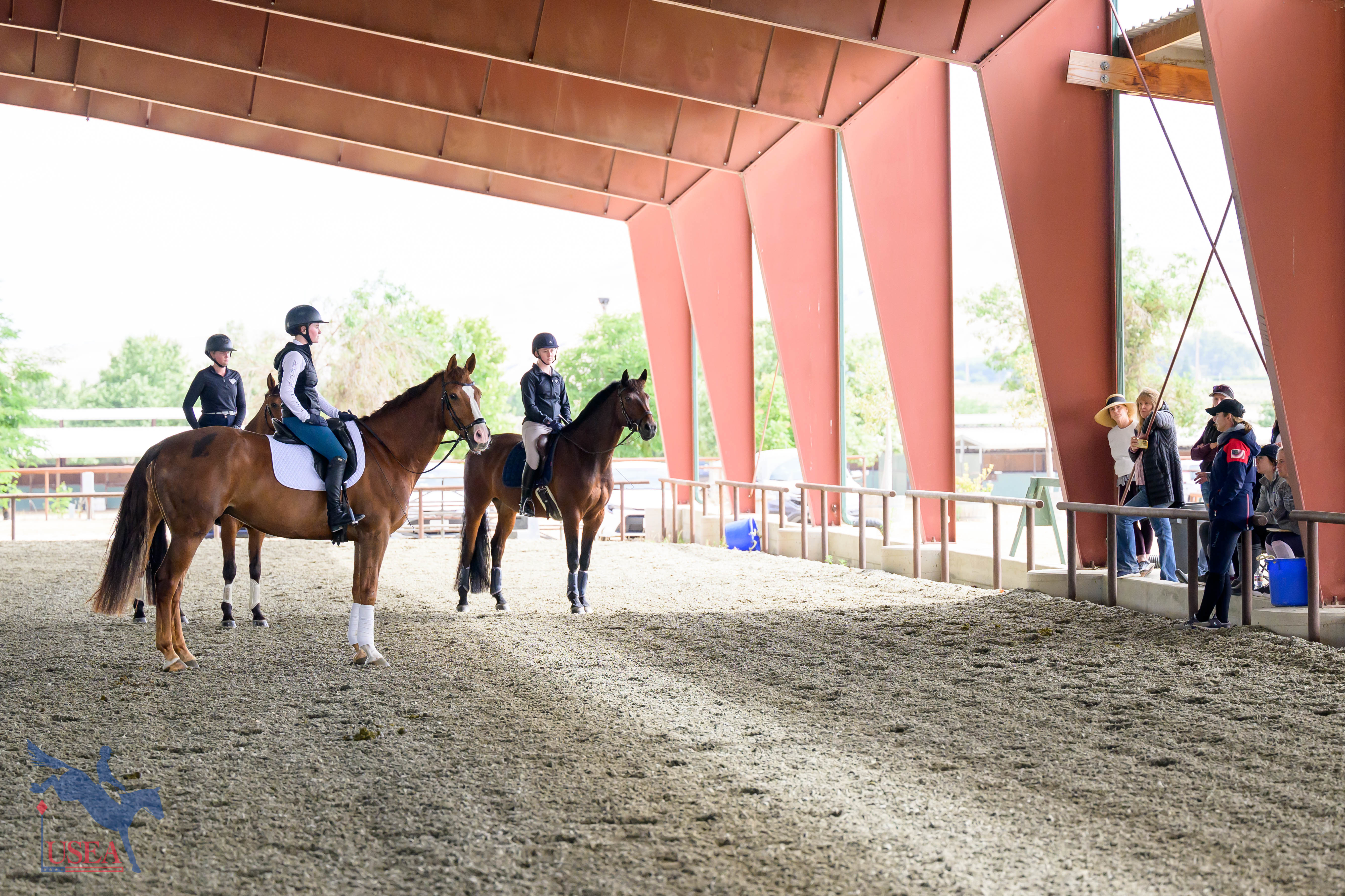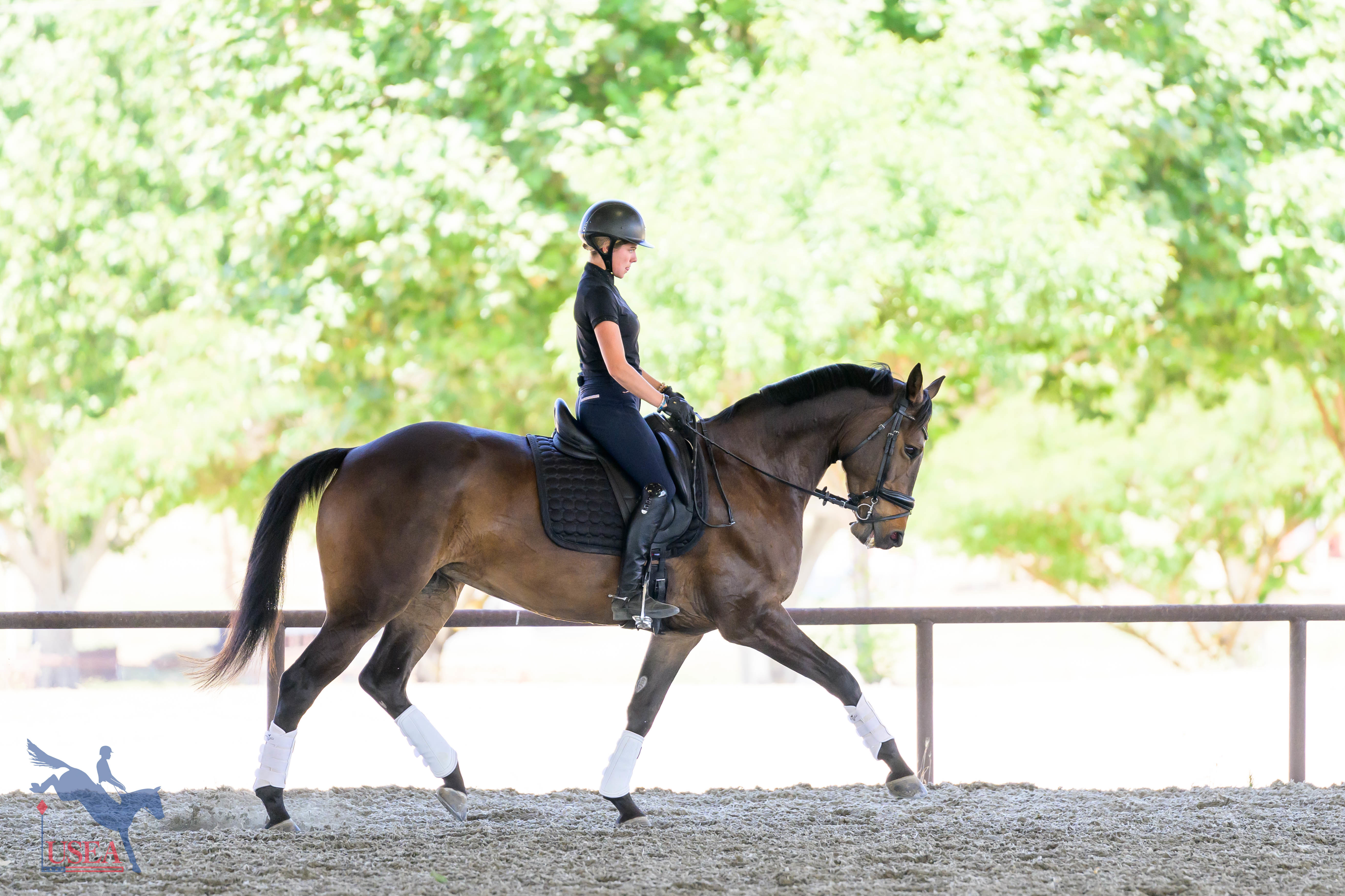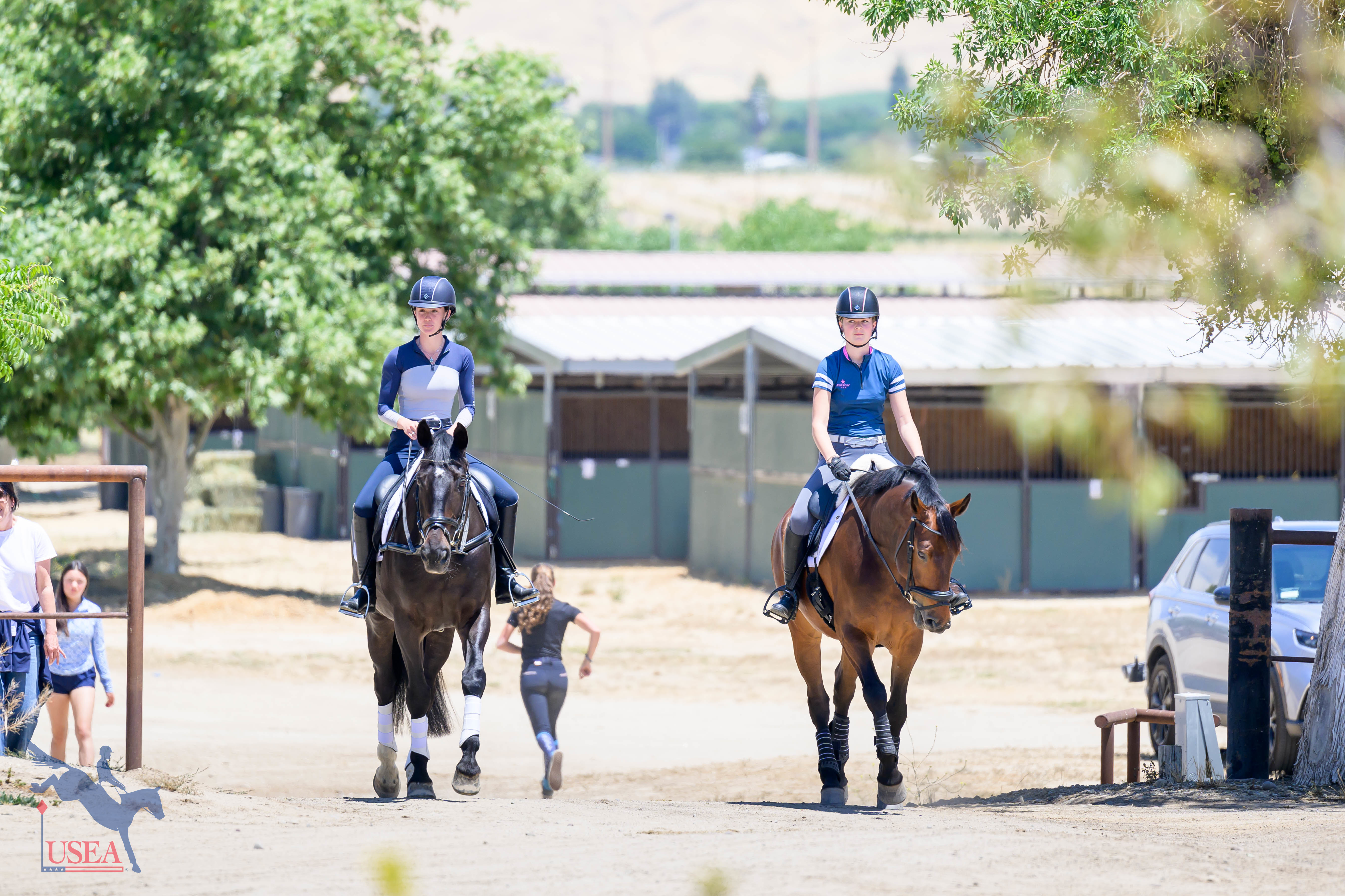Renew Your USEA Membership for the 2023 Season Today LEARN MORE

A chilly morning dawned on the USEA Emerging Athlete U21 (EA21) Regional Clinic at Twin Rivers Ranch, headed by West Coast EA21 coach Rebecca Brown of Dallas, Texas. A woman who wears many hats and is supremely committed to the sport, Brown is an ECP Level 3 coach, FEI 4* rider, U.S. Dressage Federation bronze and silver medalist, co-chair of the USEA Young Rider Committee, member of the EA21 Task Force, and founding member of the EA21 program.
The day began with a dressage lecture focused on unpacking the German training scale and attended by both auditors and athletes. Brown reiterated over and over that the purpose of this clinic, and EA21 program as a whole, is to help strengthen and create a foundation of education in emerging riders. Part of an effort to develop the pipeline for young talent, inspired by the beireiter certification in Germany, the EA21 program qualification begins at Training level and has the flexibility to see riders as a whole with lectures in the three phases, horsemanship, and barn management alongside riding.
“It’s not about your results,” she said first thing. Work ethic, adaptability, and trainability exceeds good results, financial means, and amount of showing.

Once clinic members mounted up, the focus on the German riding scale continued. Rhythm, suppleness, contact, impulsion, straightness, and collection form the pyramid of German training and Brown continued to circle back to those concepts as she brought the same exercises to bear from Training riders to Intermediate.
Focused on slowing down to hone in on the basics, three riders at a time warmed up under Brown’s observant eye before providing their analysis of both their own horses’ strengths and weakness and their fellow group members based on the six principle concepts. Then each rider was sent on a rectangle where Brown worked on polishing their basics.
She encouraged a more thoughtful and cognitive ride, even having the second group swap horses and really think about what was happening underneath them on unfamiliar mounts. “This is meant to be an education in how to ride every horse,” she explained. “As ambitious riders, we need to be honest about ourselves and our horses. You need to be more thoughtful about your ride.”
That honesty meant being specific about the details of the horse’s natural movement, what riders were asking for, and what they can do to improve their ride. “Always ask yourself as a rider do I need it before I do it,” she said. “What baggage am I bringing or not bringing? What pressure can I put on? Is the horse right-handed or left?”

Being disciplined enough to hold themselves straight and ride a proper corner rather than allowing themselves to be lured into a half circle short side was a theme. In the lecture, Brown described the different roles of the parts of the body: legs for energy, seat for tempo and stride length, upper body for balance, and hands for finesse and polish. Those roles were tested as she worked with each rider on creating more brilliance in their riding.
Bravery and consistency emerged as other themes of the day. “You cannot be afraid of impulsion,” Brown said again and again. “Carl Hester [in his masterclass at Ocala] said that when a horse gets good at collected trot, it’s almost like it’s a medium trot because they have so much power in the hind.” Being braver in practice meant being OK with a trot that ran away in order to bring it back for the creation of more powerful impulsion.
A consistent test that lacks brilliance but is precise and adheres to the training scale of being rhythmic, relaxed in the body, through in the contact, energetic in impulsion, specific in the straightness of track, and powerful in the collection will not only show more correct training but will also score better.
After each rider worked through the rectangle exercise, Brown brought more specific and individualized instructions to each. Some riders she had ride without stirrups and some she had work through various movements of their dressage tests.

Lauren Crabtree, riding her own mount Excellence, was the demonstrator of an exercise Brown referenced over and over. A piece of baling twine was tied to the D-rings on the pommel of her dressage saddle and Crabtree was asked to hold the twine with her outside hand. By enforcing a steadier outside rein, energy could be created to maintain better straightness. Indeed, Crabtree’s ride improved with the use of the twine and straightness came easier.
“How you get [through the pyramid] is the real art of riding,” Brown stressed as the riding portion of the day came to close and she welcomed questions from riders on the ground, as she had all day.
New to this year was a horsemanship lecture in which no stone was left unturned. Prior to the clinic, participants were sent a document put together by Max Corcoran and Emma Ford listing the main points of knowledge anyone pursuing coaching certification would be required to know. Confirmation, body condition, shoeing, hauling, feed, vet checks, injury care, after care, and the most interesting subject for the participants, fitness. Participants lost their shyness when addressing this all important topic. “Fitness is not just about cross-country,” Brown clarified. “It’s about getting to the final day and jumping well and being competitive.”
Lightness had been discussed previously in the day in terms of how to manage the power created by proper impulsion and engagement harnessed in collection. It returned in the horsemanship lecture as something to look for in confirmation, soundness, and fitness. Lightness in carriage and in weight helps keep horses sounder for longer, Brown explained. “For every pound in the body, you are putting wear and tear on the knees,” she added.
The EA21 clinic at Twin Rivers Ranch resumes tomorrow with a show jumping lecture and riding instruction.
Don't forget to follow the USEA’s coverage on social media!
Facebook | Instagram | Twitter
About the USEA Emerging Athlete U21 Program (EA21)
The purpose of the USEA Emerging Athletes U21 Program (EA21) is to identify and provide consistent quality instruction to the next generation of elite event riders. The aim is to create a pipeline for potential team riders by identifying and developing young talent, improving horsemanship and riding skills, and training and improving skills and consistency.
The USEA Emerging Athletes U21 Program was launched in 2022 with a model of five summertime regional clinics taught by selected USEA Eventing Coaches Program (ECP) instructors, leading to a winter national camp consisting of selected Young Riders from the regional clinics. Athletes who are 21 years or younger, are current members of their USEA Young Rider Area program, and are established at the Training Level or higher, are eligible to apply for the EA21 program. Click here to learn more about the USEA EA21 Program.
The USEA would like to thank Kerrits, Ride iQ, Sidelines Magazine and WeRideTogether for sponsoring the USEA Emerging Athletes U21 Program.